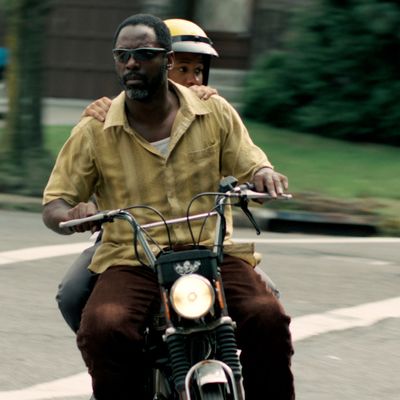
Alexandre MoorsÔÇÖs impressionistic noir Blue Caprice takes its title from the old car driven in 2002 by the Beltway snipers John Allen Muhammad and his surrogate teenage son, Lee Boyd Malvo. ItÔÇÖs also the basis of the filmÔÇÖs palette (pale, shivery) and pervading sense of aimlessness. ThereÔÇÖs a lot of arty loitering here, some of it evocative. The movie opens with snippets of news footage of the real spree and capture, but what follows is the opposite of a policier. WeÔÇÖre meant to experience the day-to-day alienation of Muhammad (Isaiah Washington) and the boy (Tequan Richmond) he trains to view humans as targets rather than people. The film snaps into focus when the charactersÔÇÖ lives do ÔÇö when the site of the rifle sticking out the back of the Blue Caprice comes to rest on one of those targets.
Blue Caprice comes at a good moment. Many of us have repressed the more or less random murders of ten people in and around the nationÔÇÖs capital. Blue Caprice restores the Beltway snipers to the forefront of our minds. But the film keeps you at armÔÇÖs length. The fractured syntax throws you out of the narrative while the sociological signposts pop up like ducks in a shooting gallery. In Muhammad, Moors gives us a symbol of African-American impotence and rage, not a man.
By most lights, Washington has not been able to shake off the anti-gay slurs that got him booted from Greys Anatomy, and its likely he brought some of his resentment to the role of Muhammad. His face is hard, his posture unyielding. He recites his lines monotonically (Its like I dont exist anymore  There are some evil people in this world  They promise all this and then take it away  chew you up  just expect you to put your head down and march into the slaughterhouse  ); the only flash of emotion comes when he succeeds into molding Malvo into a killing machine and he exclaims, with delight, Ive created a monster. Has Washington hardened himself too much? Whats the point of dramatizing Mohammads transition from a good soldier to an estranged and angry father to a mass murderer if we cant at some point empathize with his pain and even see ourselves in his position? Dick Cheney once accused John Kerry of wanting to psychoanalyze the enemies of the U.S. instead of fighting them. But how can we fight  or defend ourselves against  them if we dont understand on a gut level why they do what they do?
Tequan RichmondÔÇÖs liquid eyes almost manage to do what the script doesnÔÇÖt ÔÇö make Mohammad seem like a plausible spiritual leader. His initial wariness is expressive, and you can feel the satisfaction he gets from being called a prodigy with a rifle by MohammadÔÇÖs old army buddy (a fascinatingly odd performance by Tim Blake Nelson: What does this man know of MohammadÔÇÖs intent?). But the movie substitutes milky, washed-out color and funereal music for insight. The murders are purposely un-fluid: When you see Mohammad or Malvo take a shot, you donÔÇÖt see the impact of the bullet. When you see the victim struck, you donÔÇÖt see the shooter. Moors doesnÔÇÖt dramatize the climactic hunt and capture, which IÔÇÖm sure he thinks is a mark of his non-narrative integrity but denies us what we need to see: the instant that Mohammad and Malvo know itÔÇÖs over and their different (or similar) responses. To capture a characterÔÇÖs alienation, must a filmmaker alienate us, too? Or is that strategy just a fancy way of skipping along the surface?


